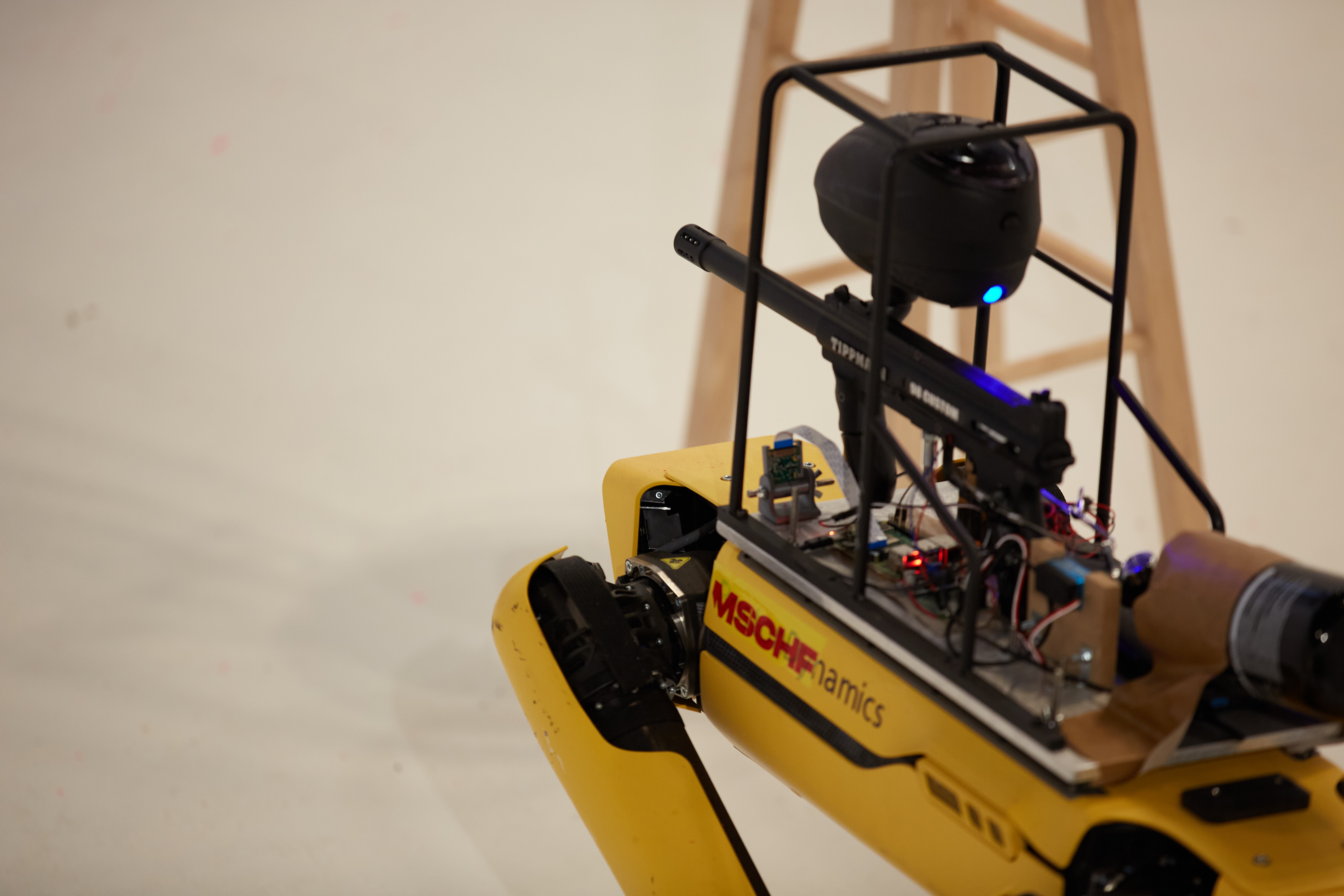Back in mid-September, a pair of Massachusetts lawmakers introduced a bill “to ensure the responsible use of advanced robotic technologies.” What this means in the simplest and most direct terms is legislation that would ban the manufacture, sale and use of armed robots.
It’s an interesting proposition for several reasons. The first is a general lack of US state and national laws governing such growing concerns. It’s one of those things that felt like science fiction to such an extent that many lawmakers had no interest in pursuing it realistically.
Of course, it’s not just science fiction, and it hasn’t been for a long time. To be fair, the United States has been using drones to kill people for over 20 years. But as crass as this sounds, people tend to view these technologies very differently when it comes to their own backyard.
However, the concern about “killer robots” is much broader than simple military applications. Some are, indeed, based on your standard Terminators. Me, Robot. and Five Nights at Freddy’s. Others are much more down to earth. Remember when MSCHF placed a paintball gun in a Spot to make a point? How about all the images of Ghost Robots with sniper rifles?
WASHINGTON, DC – JUNE 22: Gavin Kenneally, CEO of Ghost Robotics speaks as the Vision 60 UGV enters during a House hearing at the US Capitol on June 22, 2023 in Washington, DC. The House Committee on Oversight and Accountability Subcommittee on Cybersecurity, Information Technology and Government Innovation met to discuss the use of technology at US borders, airports and military bases. (Photo by Tassos Katopodis/Getty Images)
While not yet an everyday occurrence, there is also precedent for police officers using robots to kill. The week of Independence Day 2016, the Dallas Police Department kill a suspect by planting a bomb in a bomb disposal robot. Whatever you think about the wisdom and morality of such a move, you cannot credibly argue that the robot did the job it was built to do. Quite the opposite.
More recently, the potential use of armed robots by law enforcement has been a political lightning rod in places like Oakland and San Francisco. Last October, Boston Dynamics joined forces with Agility, ANYbotics, Clearpath Robotics and Open Robotics in signing an open letter condemning the weaponization of “general purpose” robots.
It read in part:
We believe that adding weapons to remotely operated or autonomous robots that are widely available to the public and capable of navigating previously inaccessible locations where people live and work raises new risks of harm and serious ethical issues. Weaponized applications of these newly capable robots will also damage public trust in the technology in ways that undermine the enormous benefits they will bring to society.
With that in mind, it shouldn’t come as much of a surprise that the manufacturer of Spot played a key role in planting the seed of this new proposed legislation. Earlier this week, I spoke about the bill with Massachusetts State Representative Lindsey Sabadosa, who co-sponsored it with Massachusetts State Senator Michael Moore.


MA Rep. Sabadosa. Image Credits: Representative Lindsay Sabadosa’s office
What is the status of the bill?
We’re in an interesting position because there are a lot of moving parts with the bill. The bill has already been debated, which is great news. We are working with the committee on the language of the bill. They had some questions about why different pieces were written the way they were. We’re doing that technical review of the language now — and we’re also checking in with all the stakeholders to make sure everyone who needs to be at the table is at the table.
When you say “interested parties” . . .
Stakeholders are companies that produce robotics. The Spot robot, which Boston Dynamics produces, as well as other robots, are used by entities such as the Boston Police Department or the Massachusetts State Police. They can be used by the fire department. So we’re talking to these people to look at the bill, talk about what the changes are. For the most part, what we’re hearing is that the bill doesn’t really change much for these stakeholders. Really, the bill is to prevent regular people from trying to weaponize robots, not to prevent the very good uses that robots are currently being put to.
Does the bill also apply to law enforcement?
We are not trying to prevent law enforcement from using the bots. And what we’ve heard time and time again from law enforcement is that they’re often used to de-escalate situations. They talk a lot about roadblock situations or hostage situations. Not to be gross, but if people are still alive, if there are injuries, they say that often helps de-escalate, rather than sending officers, which we know can often escalate a situation. So, no, we wouldn’t change any of those uses. The legislation requires law enforcement to obtain warrants for the use of robots if they use them instead of when they would send a police officer. This is already quite common. Law enforcement must do so if it is not an emergency. We’re really just saying, “Please follow current protocol. And if you’re going to use a robot instead of a human, let’s make sure the protocol is still the standard.”
I’m sure you’ve been following the stories from places like San Francisco and Oakland where there’s an effort to weaponize robots. Is this included?
We didn’t have law enforcement robots, and nobody said, “We’d like to attach a gun to a robot” from law enforcement in Massachusetts. I think because of some of those earlier conversations there was a desire not to go down that road. And I think local communities would probably have a lot to say if the police started doing that. So while the law doesn’t specifically prohibit it, we don’t condone it either.


Image Credits: MSCHF
Is there no attempt to overcome this in the bill?
Not in legislation. People using dogs to hunt by attaching guns to them and things like that — that’s not something we want to see.
Is there opposition at the moment?
We had no opposition to the legislation. We certainly had questions from stakeholders, but they were all relatively positive. We found that most people – even with proposed changes to the legislation – feel there is common ground we can come to.
What kinds of questions do you get from stakeholders?
Well, the first question we always get is, “Why is this important?”
You would think this would be something stakeholders would understand.
But many times, [companies ask] what is the intention behind it? Is it because we’re trying to do something that isn’t obvious, or are we just trying to make sure there’s no misuse? I think Boston Dynamics is trying to say, “We want to prevent potential misuse of our robots before something happens.” I think it’s clever.
Wasn’t there a backlash around issues of suffocating innovation?
I do not think. Actually, I think the robotics trade association is up and running. And then, of course, Boston Dynamics leads it. We have received thank you notes from companies but have not heard back from them. And our goal is not to stifle innovation. I think there are a lot of great things that robots will be used for. I appreciate how they can be used in situations that would be very dangerous for humans. But I don’t think putting weapons on robots is really an area of innovation that many companies are exploring.


An aerial general view during a game between the Boston Red Sox and the New York Yankees on August 13, 2022 at Fenway Park in Boston, Massachusetts. (Photo by Billie Weiss/Boston Red Sox/Getty Images)
Massachusetts is a progressive state, but it is interesting that it is among the first to pursue such a bill, as Boston is one of the leading robotics hubs in the world.
That’s why we wanted to be the first to do it. I’m optimistic that we’ll be the first to get the legislation across the finish line, too. You asked if innovation was suffocating. I’ve argued that this bill helps because it gives companies that minimum level of security to say, “We’re not making these products for nefarious purposes. This innovation is really good.” I have heard people say that we should be careful. That roboticists are just trying to create robots. That’s not what these companies do. They are trying to create robots for very specific situations that can be very useful and help save human lives. So I think it’s worth it. We see this as supporting the robotics industry, rather than trying to hinder it.
Were these stories from places like San Francisco and Oakland an inspiration behind the creation of the bill?
Honestly, I think it was for Boston Dynamics. They looked for us.
So, did Boston Dynamics drive the original conversation?
Yes, that is why, in my view, this is a bill that helps, rather than hinders.
A version of this piece first appeared in TechCrunch’s robotics newsletter, Actuator. Register here.
